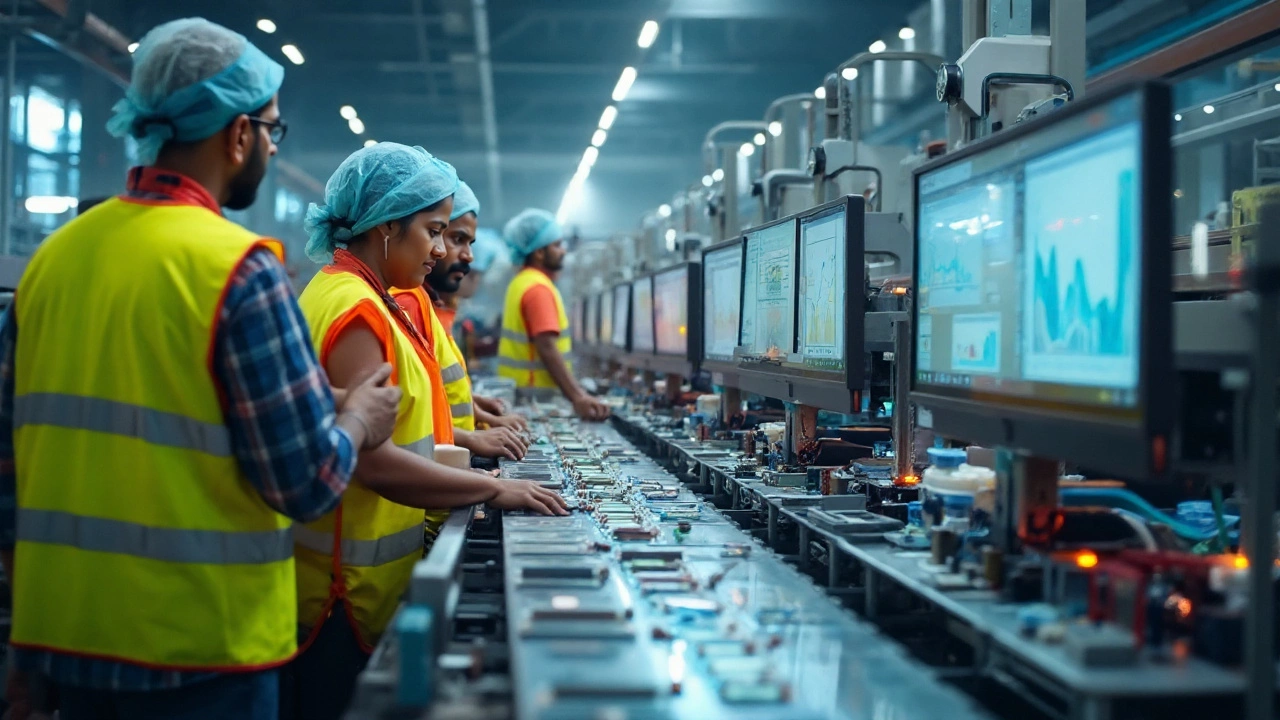Imagine one factory can turn raw stuff into gold, while another grinds all day and barely breaks even. The gap between the most profitable factories and the rest is massive—and yes, there’s a formula behind it. Investors and entrepreneurs are always chasing high-margin businesses, but spotting them in the sea of manufacturing options is trickier than you might think. Let’s cut through the noise and look closely at what factories really crank out the biggest profits today, why they work, and what lessons you can steal for your own hustle.
What Drives Profitability in a Factory?
It’s not just luck or location—a factory’s profit comes down to a few key things that most people overlook. Product value, scale, efficiency, and industry demand run the show here. Let’s pick these apart with examples everyone knows but few really study.
If you make smartphones or specialty drugs, the profit per unit is worlds apart from something like generic t-shirts. It’s all about value addition. For instance, the pharma factory churning out proprietary medicines racks up profits by selling small quantities at high prices. That’s premium value—companies like Pfizer or GSK are known for hitting gross margins above 60% in their core pharma plants.
The other big factor is volume. Take a look at Foxconn, the giant behind Apple’s iPhone assembly lines. Sure, the margin per phone isn’t sky-high, but when you’re shipping millions every month, it adds up fast. Their scale brings in steady, predictable profits, buffered by efficient automation and bargaining power with suppliers. So, even if margins look thin, raw numbers are jaw-dropping.
Efficiency is non-negotiable. Same equipment, same people, but a tweak in process or a clever bit of automation can save millions over time. Toyota plants are living proof—their legendary Toyota Production System (a.k.a. lean manufacturing) means less waste, more speed, and higher average profit margins compared to rivals. Want a stat? Toyota’s global operating profit margin hit 10.6% for 2024, while some competitors hovered just above 6%.
Still, you can have a killer product, decent scale, top-notch efficiency—and get nowhere if the market’s stagnant or too crowded. Think of textiles in Bangladesh: giant volumes, but rock-bottom prices and painfully thin margins for most players. Compare that to a small specialty food processing plant selling vegan cheese in the US. Their batch is tiny, cost per unit is high, but people pay a premium and the brand loyalty breeds steady profit.
The sweet spot? Factories where a strong brand, technical edge, and steady demand overlap. Here’s a little table to show how some sectors stack up (based on 2024 averages):
| Sector | Average Operating Profit Margin (%) | Key Examples |
|---|---|---|
| Pharmaceuticals | 25-35 | Pfizer, Roche |
| Electronics Assembly | 6-12 | Foxconn, Flex |
| Automobile Manufacturing | 8-14 | Toyota, Tesla |
| Textile / Apparel | 3-8 | Hanes, Levi's |
| Specialty Food Processing | 10-24 | Daiya, Beyond Meat |
| Furniture Manufacturing | 5-14 | IKEA, Ashley |
Notice anything? The *most profitable factory* sits in pharma or high-value specialty foods, not your average jeans mill or electronics shop. But hold up—being the most profitable doesn’t always mean being the biggest. A mid-size nutraceuticals facility with a USP-protected recipe can smoke a giant in terms of profit-per-square-meter.
Tricks of the trade? Watch for products protected by patents or with complex processes—competition stays away, margins stay fat. Combine that with smart automation and killer marketing, and you’re sitting on a goldmine. Just don’t forget about regulatory floors—high-profit factories often operate under stricter government controls. Navigating those hoops becomes a skill unto itself.

Sector-by-Sector: Real-World Factories That Print Money
So, what factories are actually making people rich right now? Let’s zoom into some real (and relatable) success stories from each sector. These are not fairy tales, and they’re not always what you might expect.
Pharma and healthcare manufacturing are the obvious big dogs. Ever heard about the Moderna factory in Norwood, Massachusetts? That site was crucial for mRNA vaccine production, pumping out millions of vials when demand skyrocketed during COVID—and the profit margins were wild. Patented drugs or specialized biotech products aren’t cheap to make, but their selling prices are off the charts. Once you’ve paid to build the plant and clear the regulations, everything else is mostly gravy—each new batch is a huge cash generator. No surprise, Moderna’s gross profit margin for 2023-24 hovered near 78% during peak demand.
But electronics is a beast of its own. Look at TSMC’s advanced chip plants in Taiwan. Everyone and their uncle wants fast, efficient chips right now. Making them is expensive and risky, but the selling price per wafer keeps rising. These factories demand crazy capital upfront, but they dominate the global supply chain—hence, why TSMC posted net margins above 40% for certain high-end chip fabrication lines last year. Not even Apple can walk away from them.
The food sector is booming in niche pockets. Take Impossible Foods’s main plant in Oakland—selling plant-based meat substitutes that cost way more than beef at the grocery store, and people still line up. The secret? Strong branding, patented recipes, and a fanbase willing to pay double for a burger patty. Here, profit margins can reach 20% or more, with almost recession-proof demand from health and climate-conscious eaters.
What about good old-fashioned cars? You might think the money is in the giants like Ford, but actually, luxury car plants do even better. Porsche’s Leipzig plant, for example, not only uses advanced robots but also charges sky-high prices for each car. This means their profit-per-car leaves economy car makers in the dust. Tesla’s Shanghai Gigafactory had industry watchers buzzing in 2024, with rumors of 16% profit margins—way, way above legacy brands.
Furniture factories? Well, if you picture someone whittling away in a dusty workshop, update your mental image. IKEA’s highly automated plants in Poland and other countries are streamlined to the max. The company gets away with thin shipping margins thanks to volume and super-tight supply chain control, driving home 9-12% profit at scale. Small woodworking shops really only make a killing if they specialize—think custom reclaimed tables for hipster restaurants, where the client pays three times the cost for the story behind the piece.
The wildcard: plastics and chemicals. Remember how Procter & Gamble gets half its profit from just a handful of factories making beauty and cleaning products? Those huge chemical plants have margins of 15% or higher thanks to patent-protected blends and strong global brands. But it’s a volatile game, since one spike in raw material costs or a regulatory crackdown can wipe out a year’s profits fast.
At the tail end are sectors like textiles where every penny counts. Giant factories in Vietnam might have 5,000 workers sewing T-shirts for Walmart, but after wages, shipping, and razor-thin contracts, profits are almost invisible. The only folks winning here are those who figure out logistics at mind-blowing scale or control a unique niche (like organic cotton or luxury sportswear with locked-in contracts).
Tired of just reading stats? Here’s a list for anyone actually considering opening, buying, or investing in a factory that could be truly profitable—and not just theoretically:
- Look for intellectual property protection—patents, copyrights, unique recipes, or processes.
- Aim for high-value products where the cost of goods sold (COGS) is a fraction of the final selling price.
- Pursue industries with regulatory barriers that keep out low-cost competitors.
- Invest in automation, but make sure it fits the product. Over-automation in custom products eats margin.
- Build strong supply and distribution relationships to keep bargaining power on your side.
- Cultivate brands consumers trust—especially in health, food, and lifestyle goods, where margins live and die by reputation.
- Don’t ignore after-sales service, especially for electronics and vehicles. This is where recurring revenue hides.
- Chase trends with staying power—think plant-based foods, green chemicals, specialty health products, and premium electronics. Fads burn out, but persistent demand means consistent cash flow.

Your Takeaway: Tips for Spotting or Building a Profitable Factory
If you want to get beyond wishful thinking and really spot (or create) a factory that crushes it on profits, focus on the details below. Not every tip will fit every industry, but missing even one can cost you millions in lost margin.
First, always start with the market, not the machinery. Find a genuine demand where people or businesses will pay extra for what you make. Get as specific as possible: dog arthritis meds, rare auto parts, gluten-free dessert crusts—these niches let you raise prices without losing customers.
Second, leverage location for advantage, not just cost-cutting. For example, building where power and water are cheap saves you endless headaches, but being close to buyers, skilled labor, or an export port can mean faster delivery (and fewer delayed orders). That’s why so many smart electronics plants cluster near major cities in China—or why pharma giants set up near university towns with ready scientists.
Third, automate intelligently. Don’t spend millions on robots if skilled craftspeople deliver better results. But for most bulk products, a custom automation setup pays for itself faster than new workers. The world’s most profitable factories find their unique automation sweet spot and keep refining it—no two setups are identical.
Fourth, buffer yourself from supply chain shocks. After the chaos of 2020-2021, everyone woke up to the risk of single-sourcing parts from one country. Running a most profitable factory now means backing up your suppliers, holding key stock, and building local relationships. It isn’t sexy, but it keeps the lights (and profit) on when competitors go dark.
Fifth, use data constantly. The top-performing factories of 2025 have real-time dashboards tracking energy use, raw material pricing, equipment uptime, and output quality. Toyota, TSMC, and even smaller innovators like Beyond Meat watch their numbers closer than Wall Street traders. They don’t wait for problems; they predict and prevent them.
One word about risk: high-profit factories often run close to regulatory or political fire. Meds, chemicals, food, gadgets—governments love to change the rules, slap on new taxes, or halt shipments out of nowhere. Always have a strategy for quick compliance or alternative markets lined up. This is why most profitable factories have teams focusing just on updating paperwork and building lobbies with local officials.
If you’re still hunting for the single most profitable factory type, the answer keeps changing. Ten years ago, it was semiconductors. Four years back, vaccines. Now, biotech (like CRISPR gene editing plants), smart battery factories, and niche functional foods are crushing it. But here’s the trick—the golden thread in all these is some mix of high value, tight control, innovative process, and fast adaptation to changing markets.
The last word—sometimes the best move isn’t copying what worked elsewhere, but looking for hidden opportunities where others aren’t digging. Maybe it’s a boutique plant making sensors for EVs, a craft whiskey distillery with a viral brand, or a plastic recycling startup with its own proprietary blend. Each big factory success once started as a weird little niche that nobody believed could be *the most profitable factory* until it was. The next legend could be yours.
